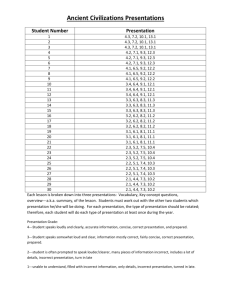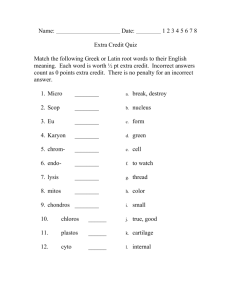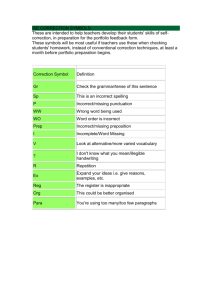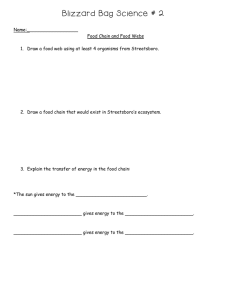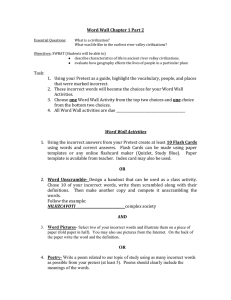More Viruses-Bacteria-Evolution Practice Question 1
advertisement
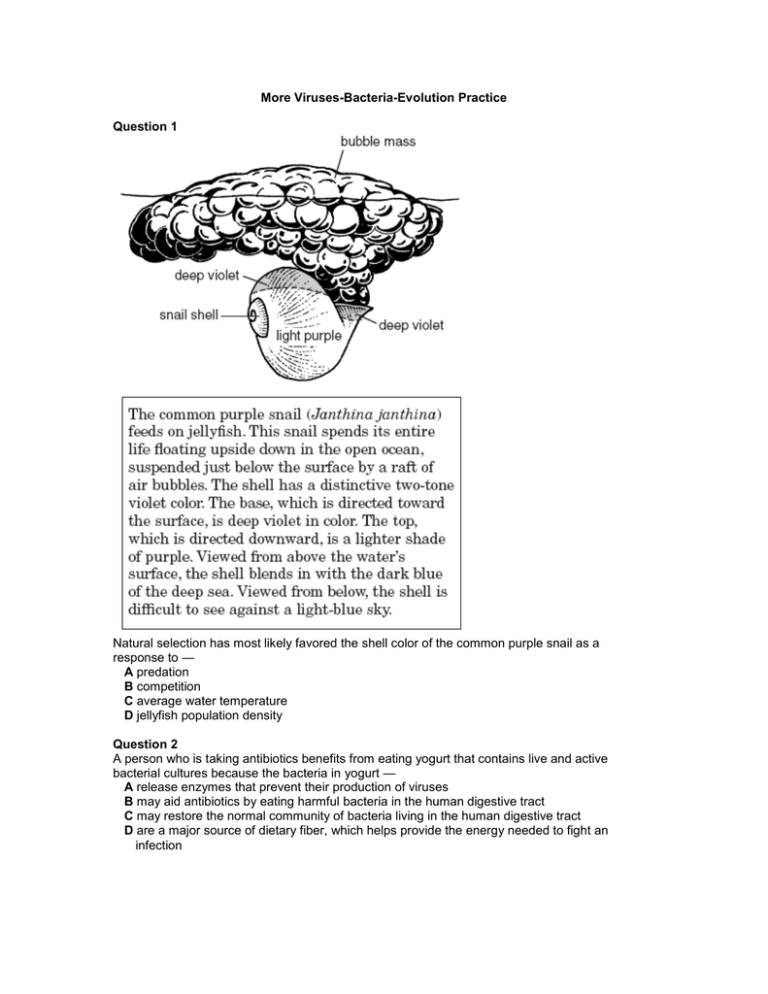
More Viruses-Bacteria-Evolution Practice Question 1 Natural selection has most likely favored the shell color of the common purple snail as a response to — A predation B competition C average water temperature D jellyfish population density Question 2 A person who is taking antibiotics benefits from eating yogurt that contains live and active bacterial cultures because the bacteria in yogurt — A release enzymes that prevent their production of viruses B may aid antibiotics by eating harmful bacteria in the human digestive tract C may restore the normal community of bacteria living in the human digestive tract D are a major source of dietary fiber, which helps provide the energy needed to fight an infection Question 3 Which statement about the evolutionary history of jawed fishes is supported by the diagram? A Jawless fishes became extinct after jawed fishes evolved. B The first amphibians were direct descendants of lungfish. C Ray-finned and lobe-finned fishes have a common ancestor. D Sturgeon are more closely related to sharks than to coelacanths. Question 4 Which seed type will most likely be carried by the wind? Question 5 Tropical rain forests support the most-diverse plant communities on Earth. This biome has developed in regions near the equator that are characterized by abundant precipitation and the absence of freezing temperatures. The consistently warm to hot weather and abundant moisture promote rapid chemical weathering and the decay of organic matter. These processes produce thick, nutrient-poor soils. Plants play a significant role in tropical rain forests by — A producing thick soils that promote the decay of organic matter B preventing erosion and allowing nutrients to accumulate in the soil C holding most of the available nutrients within their biomass D providing insulation and trapping heat that contributes to the high annual temperatures Question 6 Tuberculosis, or TB, is a contagious bacterial disease that usually occurs as an infection of the lungs. The symptoms of this disease include persistent coughing, fever, fatigue, night sweats, and unexplained weight loss. TB can be treated with antibiotics. Tuberculosis is most likely transmitted — A by mosquito bites B by blood transfusions C through the air D through water Question 7 Plants and animals are dependent on some bacteria because these bacteria — A help recycle simple nutrients to the soil B get energy from fermentation rather than respiration C are able to make their own food by using energy from sunlight D are engineered to remove hazardous wastes from the environment Question 8 The illustration in the box shows the bones in the hind foot of a modern horse. The other illustrations show the bones in the hind feet of three extinct species. Each of these extinct species is an ancestor of the modern horse. (The illustrations have been scaled so that all of the species seem to be the same size.) Which lists the extinct species in order from most closely related to the modern horse to most distantly related to the modern horse? A 1, 3, 2 B 2, 1, 3 C 2, 3, 1 D 3, 2, 1 Question 9 Since the 1940s, chemical insecticides have been used to control insects in an effort to limit crop damage and the spread of insect-carried diseases. Chemical control efforts fail, however, when insect pests become resistant to insecticides. The increase in the number of insecticide-resistant insect species is mainly a result of — A natural selection B learned behavior C geographic isolation D asexual reproduction Question 10 Golden-cheeked warblers are an endangered species of bird that nest only in central Texas. They build their nests using bark from ash juniper trees and feed on spiders and insects. Brownheaded cowbirds sometimes lay eggs in warblers’ nests. Blue jays are known to eat young birds, including the golden-cheeked warblers’ offspring. The survival of golden-cheeked warblers would be most threatened by an increase in the — A spread of a virus fatal to blue jays B predation of cowbirds by red-tailed hawks C clearing of ash juniper trees for farmland D local spider population because of mild winters Question 11 An oleander is a type of evergreen shrub. The tissues of oleanders contain chemicals that are poisonous to many mammals, including humans, horses, cattle, and sheep. The production of poisonous chemicals most likely benefits oleanders by deterring or even killing many types of — A bacteria B herbivores C pollinators D scavengers Key on Next Page Key Question 1 A Correct. The two-tone color of the shell is most likely a form of camouflage that makes detection by predatory birds and fish difficult. To get this question correct, it is not important to know everything (or anything) about common purple snails. But it is very important to read the question carefully and understand the basic concept of natural selection. B Incorrect. The common purple snail is unable to swim and relies on random encounters with prey organisms. Shell color plays no role in feeding or in competition with other organisms. C Incorrect. Shell color is not an adaptation to average water temperature. D Incorrect. Shell color offers no selective advantage for locating prey or increasing the number of encounters with prey organisms. Question 2 A Incorrect. There is no evidence that the bacteria in yogurt prevent or stop viral reproduction. B Incorrect. The bacteria in yogurt do not eat other bacteria. C Correct. Antibiotics cannot tell the difference between helpful and harmful bacteria. This means that most antibiotics will act upon many types of bacteria in the human body, including bacteria in the digestive tract needed for good health. D Incorrect. Dietary fiber is the part of a plant’s tissue that cannot be digested by humans. Yogurt is made from milk, not plants, so it does not contain dietary fiber. Question 3 A Incorrect. Jawed fishes descended from primitive jawless fishes. The diagram does not show the evolutionary history of jawless fishes. Therefore, it is not possible to know whether they are extinct. B Incorrect. According to the diagram, amphibians evolved from lobe-finned fishes but not directly from lungfish. C Correct. All ray-finned and lobe-finned fishes have bony skeletons. The diagram shows that ray-finned and lobe-finned fishes evolved from an older type of bony fish. D Incorrect. According to the diagram, sturgeon and coelacanths both evolved from a common ancestor, the bony fishes. Sharks evolved from cartilaginous fishes. Question 4 A Correct. When this evergreen cone opens, it releases small seeds with papery “wings.” The lightweight seeds are carried on wind currents and are deposited some distance from the parent plant. B Incorrect. These berries may be eaten by a bird or mammal. The seeds in the berries will pass unharmed through the animal’s digestive tract. They are then deposited at a location some distance from the parent plant. C Incorrect. Seeds such as this cocklebur catch in the fur of animals or on clothing and are carried some distance from the parent plant. D Incorrect. Coconuts may germinate on the beach close to their parent trees, or ocean currents may carry them to a different location. Question 5 A Incorrect. Thick soil forms in tropical rain forests because warmth and moisture cause intense chemical weathering and the rapid decay of organic matter. The shallow roots of rain-forest plants have little effect on these processes. B Incorrect. The vegetation in a tropical rain forest does limit erosion. However, the lack of significant erosion does not cause nutrients to build up in the soil. Rather, nutrients are quickly removed by plants. C Correct. Organic matter on the forest floor is rapidly decomposed and recycled because of the warm, moist conditions and the presence of numerous decomposers. Nutrients are quickly removed by plants, so most nutrients are stored in the biomass of the organisms that live in the rain forest. D Incorrect. The vegetation in a tropical rain forest may moderate daily temperature variations, but the high temperatures throughout the year are due to the location near the equator. Question 6 A Incorrect. Although mosquitoes can transmit diseases such as malaria and yellow fever, they play no role in the transmission of tuberculosis. The lungs are the usual site of such an infection. B Incorrect. It may be possible to spread tuberculosis bacteria through a blood transfusion, but it is unlikely. These bacteria most often reside in the lungs, and blood donors are carefully screened. C Correct. Tuberculosis is spread from person to person through the air. The lungs are the usual site of this disease. When a person with active tuberculosis coughs, sneezes, or speaks, droplets containing the bacteria are expelled from the lungs. If another person inhales these airborne droplets, that person can become infected with tuberculosis. To get this question correct, it is not important to know everything (or anything) about tuberculosis. But it is very important to read the question carefully and understand that diseases of the lungs will most likely be transmitted through the air. D Incorrect. The bacteria that cause tuberculosis are not transmitted by contaminated water. They reside only in living hosts. The lungs are the usual site of a tuberculosis infection. Question 7 A Correct. Some bacteria are decomposers. Decomposers break down organic materials and return nutrients such as carbon, nitrogen, and sulfur to the soil. Plants need these nutrients in order to grow. Animals, in turn, get these nutrients by eating plants or by eating other animals. B Incorrect. Some bacteria do get energy from the process of fermentation. During fermentation, energy is released from sugar molecules without the use of oxygen. Most plants and animals are not dependent for their survival on bacteria that use fermentation. C Incorrect. Some bacteria do make their own food using the energy from sunlight. However, so do green plants. Green plants, rather than bacteria, are the producers in most terrestrial food chains. D Incorrect. People have used certain types of bacteria to clean up hazardous wastes. However, there are usually better ways to remove such wastes. Question 7 B Correct. Species 2 is the most closely related to modern horses, and it should be listed first. The bones of Species 3 have the least resemblance to those of the modern horse. Species 3 is the most distantly related to modern horses, and it should be listed last. The correct order is 2, 1, 3. Question 9 A Correct. An insecticide never kills all the targeted insects in a population. A few insects have genetic variations that allow them to resist the effects of the insecticide. These insects produce some offspring that are also resistant to the insecticide. These offspring have a better chance of surviving and reproducing. B Incorrect. Insecticide resistance is due to genetic variations rather than learned behavior. C Incorrect. Geographic isolation occurs when a population of organisms becomes separated from the rest of its species by a physical barrier, such as a river, an ocean, or a mountain range. D Incorrect. Species that reproduce asexually tend to have less genetic variation than species that reproduce sexually. For this reason, species that reproduce asexually would be less likely to have genetic variations that allow resistance to insecticides. Question 10 A Incorrect. The spread of a virus fatal to blue jays would lead to a decrease in the blue jay population. As a result, there would be fewer blue jays to prey on young golden-cheeked warblers. This might cause the population of golden-cheeked warblers to increase. B Incorrect. Cowbirds harm golden-cheeked warblers by laying eggs in the warblers’ nests. The warbler parents feed the young cowbirds along with their own offspring. As a result, the warblers’ offspring receive less food and are less likely to survive. If there were fewer cowbirds as a result of increased predation, the population of golden-cheeked warblers might increase. C Correct. The clearing of ash juniper trees would mean fewer trees from which the warblers could get bark for their nests. If the birds could not find enough bark, they might not build nests or reproduce. As a result, their population might decrease. D Incorrect. Golden-cheeked warblers feed on spiders, so an increase in the spider population would likely mean more food for the warblers. As a result, the population of golden-cheeked warblers might increase. Question 11 A Incorrect. Chemicals that are poisonous to many types of mammals might not necessarily be poisonous to many types of bacteria. In addition, it would not benefit oleanders to kill some types of bacteria, such as those that add nitrogen compounds to the soil. B Correct. Herbivores are animals that feed on plants. Oleanders have a better chance of surviving and reproducing if they deter or kill animals that might feed on them. C Incorrect. Pollinators help many types of plants reproduce by transferring the plants’ pollen. It would not benefit oleanders to deter or kill the animals that help them reproduce. D Incorrect. Scavengers are carnivores that feed on dead animals. Scavengers are not likely to have any harmful effect on oleanders, so it would not benefit oleanders to harm scavengers.
